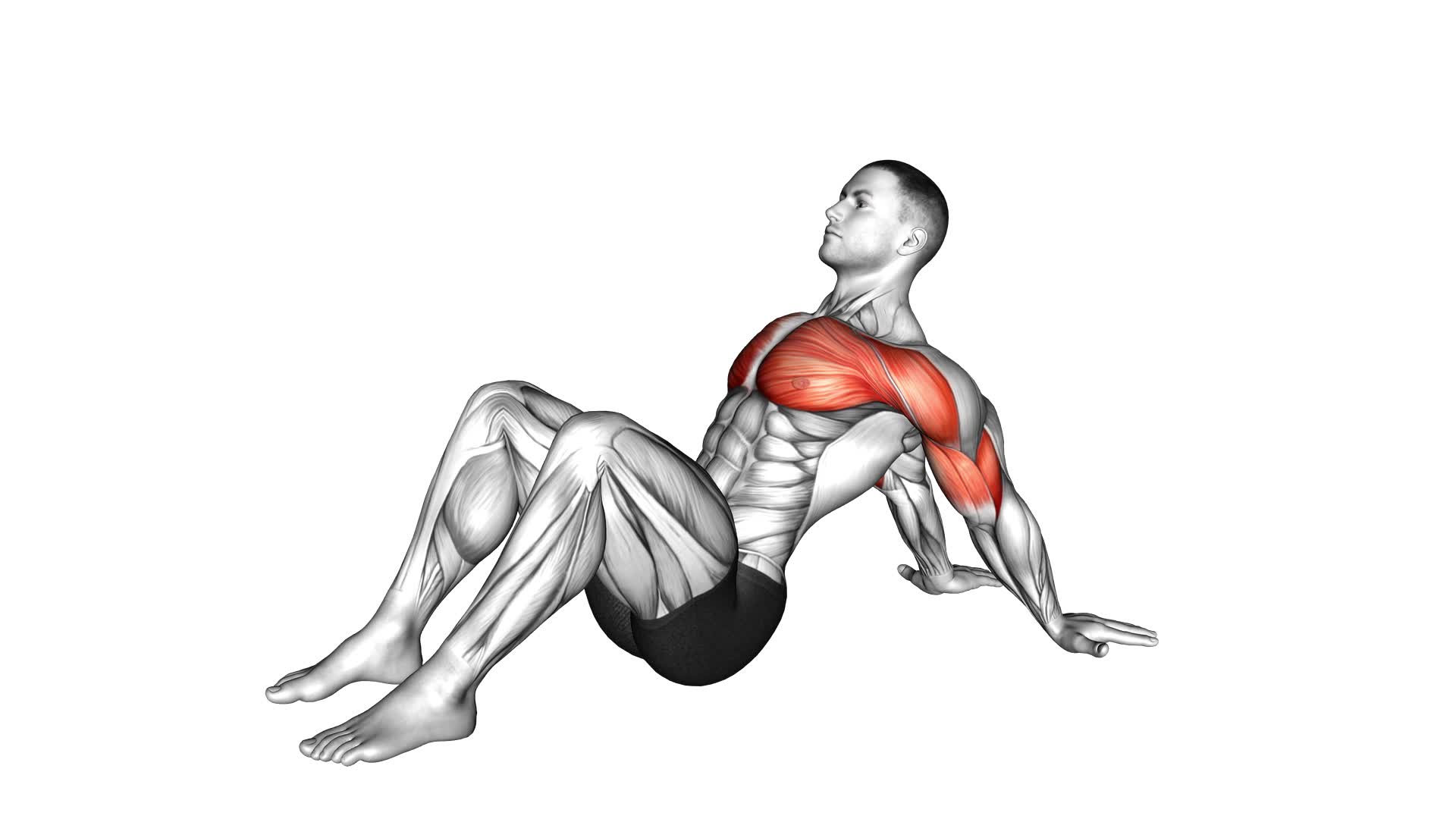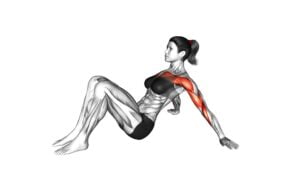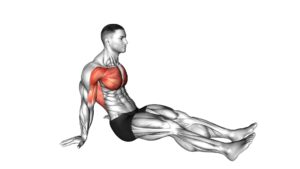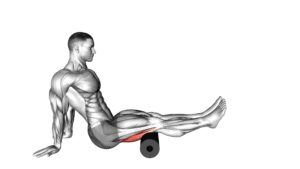Seated Shoulder Flexor Depressor Retractor Stretch Bent Knee – Video Exercise Guide & Tips

Are you looking for an effective way to stretch your shoulder muscles?
Watch This Exercise Video
Then the Seated Shoulder Flexor Depresor Retractor Stretch Bent Knee is perfect for you.
This video exercise guide will show you step-by-step instructions on how to perform this stretch correctly.
By following these tips and avoiding common mistakes, you can ensure proper form and maximize the benefits of this stretch.
Get ready to improve your shoulder flexibility and relieve tension with this simple yet effective exercise.
Key Takeaways
- Increased flexibility
- Improved posture
- Targets muscles in shoulders and upper back
- Releases tension
Benefits of the Seated Shoulder Flexor Depresor Retractor Stretch Bent Knee
You'll experience increased flexibility and improved posture with the seated shoulder flexor depressor retractor stretch bent knee. This exercise targets the muscles in your shoulders and upper back, helping to release tension and improve overall mobility. By sitting with your knees bent and feet flat on the ground, you create a stable base for the exercise, allowing you to focus on the movement of your shoulders.
As you reach your arms overhead and then lower them behind you, you'll feel a deep stretch in the front of your shoulders and chest. This stretch helps to counteract the effects of sitting for long periods, which can lead to rounded shoulders and poor posture. Incorporating this exercise into your routine can help to correct these imbalances, allowing you to stand taller and move more freely.
Additionally, the seated shoulder flexor depressor retractor stretch bent knee can be modified to suit your individual needs. You can use a foam roller or a towel to support your back if you have limited flexibility, or you can perform the exercise with your hands clasped behind your head to increase the intensity. By experimenting with different variations, you can tailor this stretch to meet your specific goals and abilities.
Equipment Needed for the Seated Shoulder Flexor Depresor Retractor Stretch Bent Knee
To perform the Seated Shoulder Flexor Depresor Retractor Stretch Bent Knee, you'll need minimal equipment. All you need is a sturdy chair or bench to sit on. The chair should have a backrest for support and stability during the exercise. This equipment is readily available in most fitness centers or can be easily found at home.
The benefits of using this equipment are numerous. The chair provides a stable base for you to perform the stretch, allowing you to focus on targeting the shoulder flexor, depressor, and retractor muscles effectively. Additionally, the backrest of the chair helps you maintain proper posture throughout the exercise, preventing any strain on your neck or lower back.
By using a chair, you can easily modify the exercise to suit your fitness level and flexibility. You can adjust the height of the chair or use cushions for added support if needed. This versatility makes the Seated Shoulder Flexor Depresor Retractor Stretch Bent Knee accessible to individuals of all fitness levels.
With the necessary equipment in place, you're now ready to proceed to the step-by-step instructions for the Seated Shoulder Flexor Depresor Retractor Stretch Bent Knee. Let's dive into the details of how to perform this exercise correctly.
Step-By-Step Instructions for the Seated Shoulder Flexor Depresor Retractor Stretch Bent Knee
To properly perform the Seated Shoulder Flexor Depresor Retractor Stretch Bent Knee, position yourself on a sturdy chair or bench with a backrest for support and stability. Follow these step-by-step instructions to maximize your shoulder flexibility during seated stretching:
- Sit upright on the chair or bench with your feet flat on the floor and knees bent at a 90-degree angle.
- Place your hands on the armrests or sides of the chair for balance.
- Bend your right knee and place your right foot flat on the floor, ensuring your right thigh is parallel to the ground.
- Extend your left leg straight out in front of you, keeping your left foot flexed and toes pointing upwards.
- Slowly lean forward from your hips, keeping your back straight, until you feel a gentle stretch in your left shoulder and back.
- Hold this position for 20-30 seconds, focusing on deep breathing and relaxing your muscles.
- Repeat the stretch on the other side by switching the position of your legs.
By following these instructions, you'll effectively target the shoulder flexor, depressor, and retractor muscles, enhancing your seated stretching routine.
Now, let's move on to some tips for maintaining proper form during the Seated Shoulder Flexor Depresor Retractor Stretch Bent Knee.
Tips for Proper Form During the Seated Shoulder Flexor Depresor Retractor Stretch Bent Knee
To maintain proper form during the Seated Shoulder Flexor Depresor Retractor Stretch Bent Knee, it's important to focus on proper body alignment and breathing techniques.
Ensure that your back is straight and your shoulders are relaxed as you perform the stretch.
Additionally, remember to inhale deeply as you prepare for the stretch and exhale slowly as you move into the stretch position.
Proper Body Alignment
You should maintain proper body alignment during the Seated Shoulder Flexor Depresor Retractor Stretch Bent Knee. Proper body alignment is crucial to ensure that you're performing the exercise correctly and effectively.
Here are some alignment tips to keep in mind:
- Sit up tall: Maintain a straight spine and avoid slouching or rounding your back.
- Engage your core: Keep your abdominal muscles activated throughout the exercise to provide stability and support.
- Relax your shoulders: Allow your shoulders to drop down and away from your ears, avoiding any tension or hunching.
By following these alignment tips, you can optimize the benefits of the Seated Shoulder Flexor Depresor Retractor Stretch Bent Knee.
Now, let's move on to the next section about breathing techniques.
Breathing Techniques
Maintain proper breathing techniques during the Seated Shoulder Flexor Depresor Retractor Stretch Bent Knee to enhance your form and maximize the benefits of the exercise.
By focusing on your breath, you can promote relaxation and engage the appropriate muscles, improving your overall performance.
As you begin the stretch, inhale deeply through your nose, expanding your diaphragm and filling your lungs. As you exhale, allow your body to relax and sink deeper into the stretch.
Take slow, controlled breaths throughout the entire movement, avoiding any breath holding or shallow breathing. By maintaining a steady flow of oxygen to your muscles, you can reduce tension and increase flexibility.
Incorporating proper breathing techniques into your routine won't only improve your form but also enhance the effectiveness of the Seated Shoulder Flexor Depresor Retractor Stretch Bent Knee.
Common Mistakes to Avoid When Performing the Seated Shoulder Flexor Depresor Retractor Stretch Bent Knee
When performing the Seated Shoulder Flexor Depresor Retractor Stretch Bent Knee, it's important to be aware of common mistakes that can lead to incorrect form and potential dangers.
One common mistake to avoid is overstretching the shoulder, which can strain the muscles and cause injury.
It's crucial to maintain proper alignment and control throughout the exercise to reduce the risk of these mistakes.
Incorrect Form Dangers
Avoiding correct form in the Seated Shoulder Flexor Depressor Retractor Stretch Bent Knee can lead to potential dangers. Maintaining proper alignment is crucial to ensure the safety and effectiveness of this exercise. Here are three common mistakes to avoid:
- Rounded shoulders: Allowing your shoulders to hunch forward can strain the muscles and ligaments in the shoulder joint, increasing the risk of injury.
- Arching the back: Overarching the lower back can put unnecessary stress on the spine and decrease the stretch in the shoulder muscles.
- Lifting the chin: Raising your chin towards the ceiling can strain the neck and compromise the alignment of the spine.
Overstretching Risks
To avoid overstretching risks, be mindful of your shoulder and back alignment while performing the Seated Shoulder Flexor Depressor Retractor Stretch Bent Knee. Overstretching can lead to injuries and should be prevented to ensure a safe and effective stretch.
It's important to maintain proper form throughout the exercise to avoid placing excessive strain on your muscles and joints. One common mistake to avoid is hyperextending your shoulder or rounding your back, as this can lead to overstretching and potential injuries. Instead, focus on keeping your shoulders relaxed and your back straight.
Additionally, be cautious not to push yourself too far into the stretch, as this can also increase the risk of overstretching. By paying attention to your shoulder and back alignment, you can effectively prevent overstretching dangers and reduce the chances of sustaining injuries during the Seated Shoulder Flexor Depressor Retractor Stretch Bent Knee exercise.
Modifications and Variations of the Seated Shoulder Flexor Depresor Retractor Stretch Bent Knee
To modify the seated shoulder flexor depressor retractor stretch bent knee, you can use a resistance band for added intensity. This modification allows you to target the muscles in your shoulders and upper back more effectively, providing an additional challenge to your workout.
Here are three variations you can try to modify the exercise even further:
- Single-Arm Resistance Band Stretch: Instead of using both arms with the resistance band, try using just one arm at a time. This variation allows you to focus on each arm individually, providing a more targeted stretch to the shoulder and back muscles.
- Standing Resistance Band Stretch: Instead of remaining seated, stand up and perform the stretch while holding the resistance band. This variation engages your core and lower body muscles, providing a full-body workout while stretching your shoulders and back.
- Resistance Band Pull-Apart: Start with the resistance band stretched out in front of you, holding it with both hands. Pull the band apart, bringing your hands out to the sides and squeezing your shoulder blades together. This variation targets the same muscles as the seated shoulder flexor depressor retractor stretch bent knee, but with a different range of motion.
Frequently Asked Questions
How Many Times a Day Should I Perform the Seated Shoulder Flexor Depresor Retractor Stretch Bent Knee?
You should perform the seated shoulder flexor depressor retractor stretch bent knee multiple times a day.
The number of sets you should do each day depends on your fitness level and goals. It's recommended to start with 2-3 sets and gradually increase as you become more comfortable and experienced.
Remember to listen to your body and never push yourself too hard.
Additionally, there are variations of this stretch that you can incorporate to target different muscle groups.
Can I Do This Stretch if I Have a Shoulder Injury?
Yes, you can modify the seated shoulder flexor depressor retractor stretch if you have a shoulder injury.
It's important to listen to your body and avoid any movements that cause pain or discomfort.
Instead, try alternative stretches that focus on gently mobilizing and strengthening the shoulder joint.
Consult with a healthcare professional or physical therapist who can provide specific recommendations based on your injury and individual needs.
Can I Use a Towel or Resistance Band Instead of a Yoga Strap for This Stretch?
Yes, you can definitely use a towel or resistance band as alternatives to a yoga strap for this stretch. Both options can be equally effective in helping you achieve the desired stretch and improve flexibility in your shoulder muscles.
Just make sure to adjust the length and tension of the towel or resistance band to suit your comfort level and ability. These modifications can provide the same benefits as using a yoga strap for this particular stretch.
How Long Should I Hold the Stretch for Maximum Benefit?
To maximize the benefits of holding a stretch, it's important to consider how long to hold it for.
The duration of the stretch will vary depending on the specific exercise and your individual flexibility. Generally, holding a stretch for at least 20-30 seconds is recommended to allow the muscles to fully lengthen and improve flexibility. However, some experts suggest holding a stretch for up to 60 seconds or longer for maximum benefit.
Remember to listen to your body and adjust accordingly.
Is It Normal to Feel Discomfort or Tightness During the Seated Shoulder Flexor Depresor Retractor Stretch Bent Knee?
Feeling discomfort or tightness during the seated shoulder flexor depressor retractor stretch bent knee is normal. It could indicate that you're effectively targeting and stretching the muscles in your shoulders.
However, make sure to maintain proper form and technique while performing this exercise to minimize any potential strain or injury.
If the discomfort becomes too intense or persists, consider modifying the stretch or consulting with a fitness professional for guidance.
Conclusion
In conclusion, the Seated Shoulder Flexor Depressor Retractor Stretch with a Bent Knee is a beneficial exercise for improving shoulder flexibility and strength.
It can be done with minimal equipment and is easy to follow with step-by-step instructions.
By maintaining proper form and avoiding common mistakes, you can maximize the effectiveness of this stretch.
Additionally, there are modifications and variations available to cater to individual needs and abilities.
Incorporating this stretch into your routine can help enhance your overall shoulder mobility and prevent injuries.

Author
Years ago, the spark of my life’s passion ignited in my mind the moment I stepped into the local gym for the first time. The inaugural bead of perspiration, the initial endeavor, the very first surge of endorphins, and a sense of pride that washed over me post-workout marked the beginning of my deep-seated interest in strength sports, fitness, and sports nutrition. This very curiosity blossomed rapidly into a profound fascination, propelling me to earn a Master’s degree in Physical Education from the Academy of Physical Education in Krakow, followed by a Sports Manager diploma from the Jagiellonian University. My journey of growth led me to gain more specialized qualifications, such as being a certified personal trainer with a focus on sports dietetics, a lifeguard, and an instructor for wellness and corrective gymnastics. Theoretical knowledge paired seamlessly with practical experience, reinforcing my belief that the transformation of individuals under my guidance was also a reflection of my personal growth. This belief holds true even today. Each day, I strive to push the boundaries and explore new realms. These realms gently elevate me to greater heights. The unique combination of passion for my field and the continuous quest for growth fuels my drive to break new ground.







